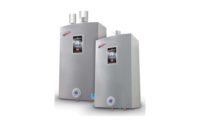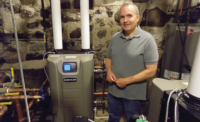You might say Joel Iverson was predestined to go tankless in his newest craft brewery in Atlanta.
The cofounder of Monday Night Brewing (MNB) — with close friends Jonathan Baker and Jeff Heck — enjoyed first-hand the benefits of tankless water-heating technology as a child growing up in Japan, where he lived for 14 years.
Limited natural resources in that country inevitably puts a premium on energy efficiency. Meanwhile, limited household square footage favors the small-to-nonexistent footprint tankless routinely provides. (Many Japanese mount their water heaters outdoors.)
But most importantly, with a properly sized tankless water heater, you never need worry about running short of hot water in the shower.
Returning to the United States as a teenager, Iverson and his family reverted to getting their hot water from a storage-tank water heater.
“I quickly learned if you’re unlucky enough to be the third or fourth person taking a shower every morning, you’re going to be cold,” he recalls. “I could never understand why Americans just didn’t switch to the better technology found in every Japanese home.”
Hot water needed…and lots of it
As it turned out, space savings and even energy savings were not the prime drivers behind MNB’s move to tankless at The Garage, the six-year-old company’s second Atlanta brewhouse, opened in the fall of 2017. But large volumes of hot water delivered continuously and at consistently correct and often high temperatures definitely were.
Located in the southwest section of the city, the new MNB barrel-aging and souring facility consumes about 10,000 gal. of hot water daily in its beer-making processes. For example, water at a temperature of 150° F is combined with barley and hops to produce an enzymatic reaction that yields a sugar. This watery “mash” then is mixed with yeast to become alcohol.
Elsewhere inside The Garage, 180° water is used to steam and sterilize its collection of wine, whiskey and rum barrels that give the various brews their distinctive flavors. “This sanitation of the wood is a critical piece of the operation,” Iverson explains. “We could do chemical sanitation of our equipment, but the best way to ensure a clean and sterile environment is hot water. And by ‘hot water,’ I mean no less than 180°.”
The solution to these demanding hot-water needs came from Noritz America in the form of five, high-efficiency (95%) water heaters. The Model NCC199-DV condensing units were pre-engineered, prefabricated and pre-plumbed with a system controller as a single, integrated package on a metal rack before being shipped intact to Atlanta — resulting in a major savings in installation labor. Their combined maximum inputs total 999,500 Btu/h, meeting not only the brewing and sanitation requirements of the beer production process, but also the general hot-water service needs of the rest of the 22,000-square-foot structure.
Beyond a continuous supply of hot water, two other criteria were equally influential in Iverson’s decision to install tankless: 1) system redundancy to keep the beer flowing and, believe it or not; 2) significantly lower, up-front purchase costs.
No more waiting
MNB’s original 30-barrel brewhouse on Trabert Ave., five miles north of downtown Atlanta, gets its hot water from a conventional steam boiler that feeds a 2,000-gal. storage tank. The drawback is identical to what Iverson encountered as a teenager when his family returned from Japan: When the storage tank runs out of hot water, all you can do is… wait. And when the boiler breaks down and needs servicing, the wait can extend for a day or two until help and/or a repair part arrive. “In these instances, we cannot do anything,” Iverson says. “There’s no backup.”
All of which led Iverson to contemplate the tankless alternative for the new brewery.
While attending a brewing industry conference, Iverson spoke with a fellow brewmaster about MNB’s plans for The Garage and the need for a more reliable source of hot water. Iverson’s new friend mentioned that a number of smaller breweries had taken to experimenting with tankless technology, rigging two or more units together to get the hot water they needed.
Iverson didn’t care for the idea of “hacking” water heaters together to build a makeshift system, but he was intrigued enough to begin researching the possibilities of connecting multiple units to generate the hot water he needed. He subsequently learned that Noritz offered a prefabricated system, including a central controller, and immediately thought, “That’s exactly what we need.”
“I contacted the manufacturer’s headquarters in California, got with someone in its technical department and walked them through my sizing calculations for the maximum flow rate of about 16 gal. per minute at 180°,” he explains.
Working back from that metric, Iverson notes Noritz tech support helped him determine that he needed a 1-million Btu system, with five heaters connected in a series.
Throughout his work with the manufacturer, Iverson says he and his colleagues never wavered from their conviction that tankless was the right choice.
“Our lone concern was what happens if a sudden need for an unusually high volume of hot water arises? So we devised a creative way to deal with that in the form of a 150-gal. holding tank,” he says. This backup tank is not absolutely required, but it does provide reassurance and peace of mind.
System redundancy at an affordable price
First and foremost among the factors persuading MNB management it was on the right track with tankless was a sharply lower acquisition cost. Iverson figures a 1-million Btu steam boiler would have demanded double the price of the installed prefabricated tankless system.
Prefabrication of the rack system accounted for some of the tank-vs.-tankless cost gap, thanks to a dramatic reduction in labor time and expense. Compared with tankless, a steam boiler is a far more complicated, labor-intensive install.
“Much of the time and expense is the steel pipe needed to connect the boiler to equipment, all of which must be insulated,” Iverson explains. “Then there are all the relief valves and other safety devices required by code. Steam boilers also must undergo regular inspections by the state, another major cost.”
It’s not a perfect apples-to-apples comparison between a steam boiler and tankless, Iverson admits, but he harbors no doubt about the more attractive economics of the latter. “We should have lower gas bills simply because tankless is on-demand: We won’t be heating water all the time — only when we need it.”
This benefit is somewhat muted by the comparatively low natural gas prices right now, Iverson explains, but “it was the up-front savings in equipment and labor that tipped the scales in favor of tankless.”
The other major attraction for MNB is system redundancy, which should all but eliminate downtime during servicing situations. “Shutdowns are a big negative in any brewery,” says Iverson, who adds the occasions when all five will operate simultaneously should be few. “That means when maintenance for one unit is required, one or more of the other four will remain online so we can continue brewing beer.”
Plug-and-play eases installation
If not exactly “plug-and-play,” the prefabricated, pre-plumbed tankless system simplified the installation considerably. Besides mounting the heaters to the rack, three in the front and two in the back, the prefab team also made all the internal water and gas connections prior to shipment. When the unit arrived at The Garage, plumbing installer David Mansfield of Mansfield Contracting (Conyers, Georgia) had to only make three connections — hot water, cold water and gas — for the entire assembly, rather than three for each of the five units. Three vs. 15: That’s an 80% reduction in connections.
As for the controller, the primary concern was to connect each of the five preinstalled cords to its appropriate unit with no wires hanging slack. Otherwise, this prefabbed piece, which can be hung virtually anywhere nearby, typically takes only 30 minutes to install.
The gas lines and vent runs were another matter. Owner David Hardegree of Winder, Georgia-based Hard-Cas Mechanical and Project Manager Tim Casper installed 3,000 feet of 2-inch black iron pipe at The Garage to service various appliances, including HVAC equipment, 12 gas lamp posts and a fire pit for brewery guests, plus the tankless setup, which needed 1,000 feet by itself. Describing the installation as a “massive undertaking,” Hardegree estimates the gas-pipe installation spanned a week.
Each tankless water heater is vented separately with a 20-foot vertical stack of 4-inch Schedule 80, high-pressure PVC pipe. Each stack consists of a pair of 20-foot lengths connected with a Schedule 40 PVC fitting. The five runs merge at the roof into a specially prefabbed by 3” x 3” x 3” wye fitting. The venting terminates in a five-foot vertical length of concentric piping, five inches in diameter. The inside pipe, which delivers makeup air, is encased in a slightly wider pipe that removes the exhaust.
The venting setup required two days, says Hardgree, “including a day on a scissor lift, after the manifold was set, to rough-in most of the pipe; and a second day to top it all out on the roof.”
But whatever the challenges the gas and vent runs presented, Hardegree only has compliments for the tankless rack system, which had to be carefully squeezed into The Garage’s 8-foot-square mechanical room.
“It was a tight fit, no question,” he states, “but once the rack was in place, the heaters were ready to go. If we had to mount each of them on the wall, we might’ve needed another week.”
Return to their roots
Hear the name, and you might well conclude Monday Night Brewing must be connected to football: a bunch of “bros” watching the pros on TV, September through December. In fact, the venture began as a pastime for the three founders who all were members of the same church in Atlanta. They would meet on — of course — Monday nights, not to watch football, but to taste each other’s latest brews and revel in the camaraderie.
“We were all white-collar dudes doing our day jobs,” Iverson says, “but always pointing to what we’d be brewing come Monday night. Instead of dreading Mondays, we actively looked forward to them.”
But after opening the “West Midtown” brewhouse on Trabert in 2011, their hobby and passion quickly transformed into a major business enterprise with all the pressures and complications that accompany rapid growth. The focus inevitably turned to making “big batches of beer and improving our efficiencies,” Iverson says. Business success certainly has its satisfactions. But the founding trio found themselves drifting away from its original intent: To foster fun, innovation and, above all, “deepening human relationships over some of the best beer in the country.”
Thus, The Garage is in many ways a return to the founding spirit of Monday Night Brewing, Iverson explains. Built along one of the country’s largest urban renewal projects, the new Westside Beltline trail, it features a public tasting room with a patio for touring guests, plus an adjacent “urban orchard” for brewing beers the old-fashioned way, via wild fermentation. Most importantly, there’s simply more room under roof.
“We have all this additional space for multiple barrel-aging and souring rooms to experiment with the sort of specialty beers that have won us so many awards,” Iverson says. “Originally, the idea seemed a little crazy, but viewed within the context of our main mission, it clearly was a step we had to take.”
In that regard, high-performance tankless technology is a good fit for an innovative enterprise committed to excellence through creative experimentation. You cannot brew beer without lots of hot water; and you can’t brew “some of the best beer in the country” without a first-rate and dependable water-heating system, Iverson concludes.
Author bio: Reginald Gholston, Sr. is a commercial account manager with Noritz America Corp. John O’Reilly is the cofounder of Frankfort, Illinois-based public relations firm O’Reilly DePalma.





